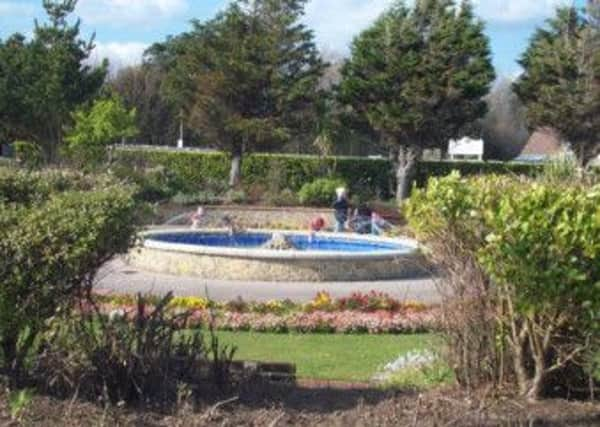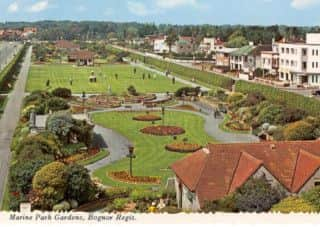Nostalgia: Bognor's Marine Park Gardens remembered


The report continued: “It is the start of what the planners hope to make into a British Estoril, Biarritz, Monte Carlo or Las Palmas – svelte, elegant and progressive in the modern trend of architecture.”
With such a report, I obviously had to look further into the whole development, and was quite surprised at what I found. The area in question is around the Marine Park Gardens of Aldwick, West Bognor. However first we should look back to the beginning of the development in this particular area. It was in 1926 when the Bognor Regis Urban District Council purchased an area of 23½ acres of land with a boundary of the Aldwick Road, the Esplanade and Mill Lane, today known as Nyewood Lane. Mr WHB Fletcher owned this land and as a result of an auction at the Royal Norfolk Hotel, the council paid £15,500. Mr Fletcher retained the rights to the seafront, foreshore and tamarisk hedge, hoping that in the future they would pass to the local authority.
Advertisement
Hide AdAdvertisement
Hide AdThe council then proceeded to sell some of the land to developers, but the council retained a length of land running parallel to the sea to be developed as a public garden. This was then to become the Marine Park Gardens we know today.


In 1931 there was a brochure produced by HW Seymour, developer and local builder, with regard to a new development, that of the Marine Park Estate. The brochure reported: “It was designed with a view to refreshing the memories of those who are acquainted with the district of West Sussex; it is a straightforward statement of fact, devoid of sentiment or stupid padding and will, we hope, create in those contemplating retirement or residence in the South, a desire for further detailed information.”
The brochure reported on the climate and vicinity, and also advised future purchasers about the type of homes, bricks, mortgages etc that were to be available, and continued: “The Marine Park Estate is Freehold, and lies immediately on the West of Bognor Regis, but enjoys the facilities offered by the town in respect to electricity, water, gas, main drainage.” Advertising literature used the visit of the King on a positive note with comments like, ‘the sea front is continuous with that of Craigweil House and Aldwick, and thus offers the sheltered healthfulness and wholesomeness, that was such a telling factor in guiding His Majesty’s Physicians to select Bognor Regis as the venue for His Majesty’s convalescence’.
This estate was finally developed and was to consist of the area we now know as Wessex Avenue, Princess Avenue. Selsey Avenue, Kings Parade and Silverston Avenue and no doubt they were to enjoy the attributes of this estate as described further in the brochure that the estate was ‘so situated that invasion by trippers, charabanc parties and others is indeed a remote contingency. Thus, residents can enjoy the quiet serenity of the seaside, minus the jangle of bands, pierrots and other impediments, inevitable common to more public parts.”
Advertisement
Hide AdAdvertisement
Hide AdBy 1935 the work had also been completed on the gardens, and they were opened by William Fletcher, who performed the opening ceremony by cutting a ribbon with a special pair of scissors. Many years later the Bognor Regis Local History Society also used these scissors when they performed the opening ceremony of their museum in Hotham Park.


In 1936 the gardens were to be well illuminated, as they appeared to be flat, with no trees, the illuminations were to enliven the area. The main decorative feature of the park was the fountain, which had an incredible 63 jets of water which ‘emitted whirling sprays of water’ over a figure in the centre, sadly no longer in situ. There were also four floodlights with special silvered glass reflectors to play on the water sprays, which was to make a focal attraction in the park.
The next major event for this area was that reported at the beginning of this article: in 1967 when another development was to take place, the main contractors were advertising the construction of ‘Marine Parade’ on Kings Parade. The development was to consist of an ‘ultra-modern group of elegant flats for those who are seeking only the best for living on the coast’. These flats were offered for sale from £6,250 to £8,500 each with a ground rent of £30 per annum, which I am sure today’s resident would welcome! The flats were to be fully carpeted and with maximum sound insulation. I was interested to read one of the attributes of these flats was the introduction ‘From across the Atlantic at last comes the highly effective automatic porter operating from the outer lobby door on the ground floor when the flesh and blood porter locks up at dusk. This consists of a microphone for callers, etc etc’. An interesting addition then, but one, which today we take as normal in blocks of flats.
These constructions were not without opposition from other local residents, because they believed that they broke a covenant, which stated ‘no house or building erected on any part of the land shall be used for any other purpose than as a private or professional resident, or as a private school or for the letting of apartment’.
Advertisement
Hide AdAdvertisement
Hide AdThose opposing these developments felt any relaxation in rulings would ‘lead to the collapse of the whole system of control on the estate’.
If you join the people who regularly walk around the Marine Park Gardens or those people who go there to take pictures, I think you will be surprised at what you can find. Firstly well-kept and maintained gardens, which are well-used by all age groups. However if you look deeper you will find a number of commemorative plaques. One such is to Mr and Mrs Bill Draper who spent many hours in the park, but Bill spent time with his father in the designing stages of the park.
Finally across the road at Sandmartins, the retirement home, there is a council Blue Plaque denoting this was the site chosen by the author RC Sherriff, to build his home and from where he wrote Journey’s End and also his Fortnight in September, which tells the story of a family coming from London by train in the 1930s to spend their holiday in Bognor.
The seafront lights were extended to the park in 2004, with the assistance of Aldwick Parish Council.
Advertisement
Hide AdAdvertisement
Hide AdA couple of months ago I received an email from Australia with a picture attached, asking me if the picture was in fact from Bognor Regis. It belonged to a group of family photos taken in 1946 by the writer’s mother. So you see how far away pictures of this very pleasant area have travelled.
Take a stroll along the seafront to see the history that is enclosed within this area.